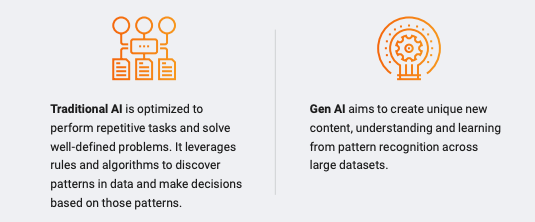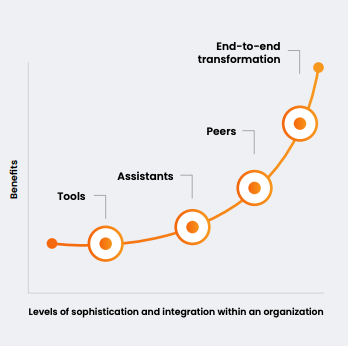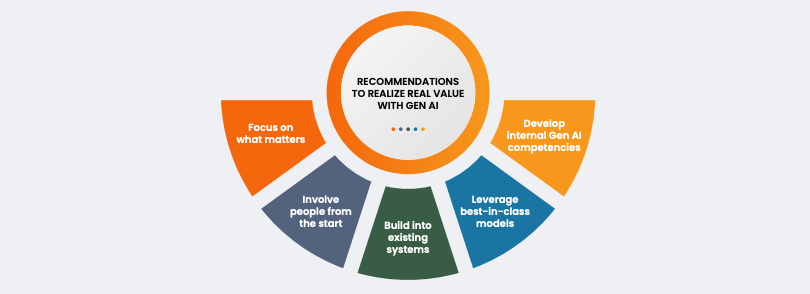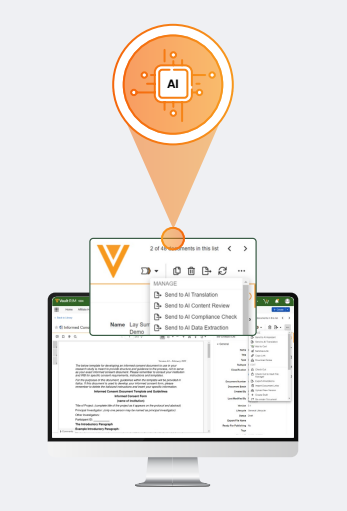White Paper
Generative AI in Clinical Operations:
Faster and Better Regulated Content
Generative AI (Gen AI) and large language models have become a strategic priority across the pharmaceutical industry and will impact the entire life sciences value chain – with patients being the biggest beneficiaries.1
However, many organizations struggle to move beyond promising prototypes and generic platforms to achieve tangible business value. This is often due to a lack of focus on critical business processes and usability challenges for end-users.
At BASE life science and Veeva, we believe a pragmatic approach is key. We advocate for focusing on AI Assistants within Veeva Vault to unlock the near-term value of Gen AI for life sciences companies. Moving beyond AI Assistants to Peers where AI can create content without human intervention is a future opportunity, but not a feasible way to obtain meaningful value from AI today.

Gen AI vs. Traditional AI: What’s the Difference?

Gen AI: Enabling the Shift from Tools to Assistants
According to MIT, the evolution of AI can be viewed as a journey towards end-to-end transformation, through Tools, Assistants, and Peers.2
- Today AI is most often used as a scoped Tool that provides specific insights or automates repetitive tasks. An example is using AI and machine learning to auto- classify the metadata in regulated content that you receive from external partners.
- As AI evolves, it transitions to an Assistant role, providing recommendations and helping in more dynamic and context-aware scenarios. An example is reviewing content to ensure compliance with Health Authority regulations. A human will almost always be required to verify the advice or content from the assistant.
- AI as a Peer is where AI collaborates with humans on tasks and makes decisions autonomously. An example is the automatic generation of a clinical study report based on the results of a clinical trial without the involvement of humans.
The life sciences industry is slowly moving from using AI as a Tool to using AI as an Assistant. To support this evolution, BASE life science and Veeva advocate for AI Assistants to achieve tangible business value in regulated content processes. This includes tasks like preparing, reviewing, and translating content, which directly influence time-to-patient and operational costs. Gen AI Assistants can significantly enhance efficiency in these areas, delivering better content more quickly.
The potential benefits of AI Assistants in clinical development are substantial, driven by the increasing volume and complexity of content, stringent timelines, and regulatory guidance such as ICH E6 (R3), the TMF Reference Model, EU CTR, and many other regional clinical trial disclosures. Gen AI Assistants offer tangible opportunities to streamline processes, accelerate approval, and improve overall efficiency.
Gen AI and large language models have matured to the point where they can significantly assist employees in content-related tasks.
Transitioning to AI Peers requires further AI advancements, clearer regulatory guidelines, and more proven use cases within the life sciences industry.
Additionally, users may be apprehensive about an AI Peer that seems to replace their roles, but they are more likely to embrace an AI Assistant that complements their work, allowing them to focus on high-value tasks and reduce manual effort.
Real-World Applications of Gen AI in Clinical Operations
Think of AI Assistants as specialized tools with specific competencies, such as experts in a specific ISO guideline, a Chinese–English translator, or proofreaders. Providing key employees easy access to relevant AI Assistants significantly reduces the time and effort spent generating regulated content while also minimizing errors and enhancing compliance with regulatory requirements.
- Document Quality Assistants
Quality control (QC) of documents, including spelling, data completion, and accurate referencing, is a manual, time-consuming, error- prone process.
By automating these reviews with Gen AI Assistants, authors can ensure that most errors are corrected before internal review, saving time and improving accuracy.
For example, AI Assistants can efficiently verify that references in large documents like a New Drug Application match their sources, a task that is challenging to perform manually. - Regulatory Review Assistants
Ensuring compliance with external regulations is a critical yet time-consuming aspect of content management.
By training Gen AI Assistants to conduct reviews based on specific regulations or standards, organizations can more effectively identify discrepancies that may have been missed during manual reviews, significantly shortening the review cycle.
For example, an Assistant focused on reviewing layman language can ensure that patient-facing content adheres to the simplicity and clarity guidelines set forth by the EMA or FDA. - Translation Assistants
Content translation and localization are often on the critical path to getting studies or new drugs approved, especially when relying on external translation agencies.
Utilizing a cutting-edge Gen AI translation Assistant enables organizations to significantly reduce translation timelines from weeks to days.
While human review remains essential, with proper training on approved company content, AI-generated translations are increasingly approaching the quality of those produced by certified translation agencies.

5 Essential Strategies to Realize the Value of Gen AI
Gen AI is ready to support the pharmaceutical industry as Assistants. To do this successfully, BASE life science and Veeva recommend following these five steps:
- Focus on what matters
The starting point should always be a prioritized business need, where AI Assistants can provide real benefits, either by streamlining the preparation of critical content for health authorities or enhancing content quality.
This necessitates early involvement from relevant subject matter experts and ongoing feedback from end-users to ensure solutions remain aligned with evolving needs.
Furthermore, AI Assistants should seamlessly integrate into existing content workflows, ensuring they are accessible to the appropriate users at the optimal time. For example, by identifying common causes of delays in regulated content approval, AI Assistants can proactively assist authors in avoiding these mistakes when creating the first draft. - Involve people from the start
To maximize the value of Gen AI, organizations should align AI initiatives with clear objectives and engage stakeholders early to build trust. The primary goal of AI Assistants is to empower end- users to perform their tasks more effectively and efficiently. Sharing feedback from early adopters on how these Assistants are achieving this objective is crucial. If Assistants are not fulfilling their intended purpose, there should be a clear mechanism for end-users to provide feedback that can be used to continuously improve AI Assistant performance. - Build into existing systems
A common barrier to widespread AI adoption is that they are implemented as standalone solutions with separate logins and user interfaces. This often requires substantial change management and reinforcement from executive leadership.
To overcome this challenge, we believe in seamlessly embedding AI Assistants directly into the source systems where people work. By adding a simple button in an existing system like Veeva rather than implementing a new solution, AI Assistants can support end-users within their normal workflows, fostering adoption and maximizing value. - Leverage best-in-class models
The rapid advancement of Gen AI has enabled the development of AI Assistants that were not feasible two years ago. As new models continue to emerge, the industry should seize the opportunity and benefit from this ongoing innovation. Rather than being restricted to specific local AI models, we recommend building AI Assistants that can leverage the best-in-class models available, regardless of cloud platform. This approach ensures Assistants remain valuable by allowing for continuous upgrades to newer, more advanced AI models. - Develop internal Gen AI competencies
AI Assistants are a crucial component for building “AI- enabled clinical operations.” To fully capitalize on their potential, pharmaceutical companies should prioritize understanding where Gen AI can meet the needs of end- users, growing the capability to build AI Assistants that support those needs, and continuously maintaining and improving a growing portfolio of Assistants while adhering to GxP compliance and security standards.

AI Assistants: The Next Frontier to Optimize Clinical Operations
Recent advancements in Gen AI have created opportunities to improve clinical operations by implementing effective AI Assistants. These Assistants can streamline labor-intensive and critical processes involving regulated content. To ensure widespread adoption, BASE life science and Veeva recommend that the industry focus on developing AI Assistants that:- Prioritize core business processes. Focus on AI Assistants that directly impact critical operational tasks.
- Deliver tangible value. Ensure Assistants provide real-world benefits to end-users, enhancing quality and efficiency.
- Build into existing solutions. Make AI Assistants readily accessible within existing workflows to minimize disruption.
- Stay ahead of the curve. Continuously update AI Assistants with the latest models and advancements to maintain optimal performance.
- Establish a strong foundation. Cultivate the necessary internal expertise and governance to support ongoing AI Assistant development.
See how AI Assistants can power more efficient clinical operations today.
1 Infosys Knowledge Institute, 2024: “Life Sciences: Trends for the Future.”
2 Thomas W. Malone, MIT Sloan Review, 2018, “How Human-Computer ‘Superminds’ Are Redefining the Future of Work.”